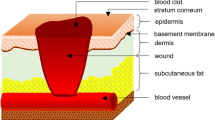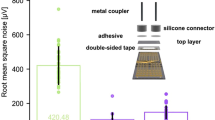Abstract
Cells are complex, dynamic systems that respond to various in vivo stimuli including chemical, mechanical, and scaffolding alterations. The influence of mechanics on cells is especially important in physiological areas that dictate what modes of mechanics exist. Complex, multivariate physiological responses can result from multi-factorial, multi-mode mechanics, including tension, compression, or shear stresses. In this study, we present a novel device based on elastomeric materials that allowed us to stimulate NIH 3T3 fibroblasts through uniaxial strip stretching or shear fluid flow. Cell shape and structural response was observed using conventional approaches such as fluorescent microscopy. Cell orientation and actin cytoskeleton alignment along the direction of applied force were observed to occur after an initial 3 h time period for shear fluid flow and static uniaxial strip stretching experiments although these two directions of alignment were oriented orthogonal relative to each other. This response was then followed by an increasingly pronounced cell and actin cytoskeleton alignment parallel to the direction of force after 6, 12, and 24 h, with 85% of the cells aligned along the direction of force after 24 h. These results indicate that our novel device could be implemented to study the effects of multiple modes of mechanical stimulation on living cells while probing their structural response especially with respect to competing directions of alignment and orientation under these different modes of mechanical stimulation. We believe that this will be important in a diversity of fields including cell mechanotransduction, cell–material interactions, biophysics, and tissue engineering.






Similar content being viewed by others
References
Chen, C. S., Tan, J., & Tien, J. (2004). Mechanotransduction at cell-matrix and cell-cell contacts. Annual Review of Biomedical Engineering, 6, 275–302.
Georges, P. C., & Janmey, P. (2005). Cell-type specific response to growth on soft materials. Journal of Applied Physiology, 98, 1547–1553.
Kumar, S., & LeDuc, P. (2009). Dissecting the molecular basis of the mechanics of living cells. Experimental Mechanics, 49, 11–23.
Wang, N., & Ingber, D. E. (1994). Control of cytoskeletal mechanics by extracellular matrix, cell shape and mechanical tension. Biophysical Journal, 66, 2181–2189.
Galbraith, C. G., Skalak, R., & Chien, S. (1998). Shear stress induces spatial reorganization of the endothelial cell cytoskeleton. Cell Motility and the Cytoskeleton, 40, 317–330.
Liu, M., Qin, Y., Liu, J., Tanswell, A. K., & Post, M. (1995). Mechanical strain induces pp60src activation and translocation to cytoskeleton in fetal rat lung cells. The Journal of Biological Chemistry, 271(12), 7066–7071.
Wang, J. H.-C., Thampatty, B. P., Lin, J.-S., & Im, H.-J. (2007). Mechanoregulation of gene expression in fibroblasts. Gene, 391, 1–15.
Liu, M., Tanswell, A. K., & Post, M. (1999). Mechanical-induced signal transduction in lung cells. American Journal of Physiology Lung Cellular and Molecular Physiology, 277, 667–683.
Langevin, H. M., Storch, K. N., Cipolla, M. J., White, S. L., Buttolph, T. R., & Taatjes, D. J. (2006). Fibroblast spreading induced by connective tissue stretch involves intracellular redistribution of α- and β-actin. Histochemistry and Cell Biology, 125, 487–495.
Cunningham, K. S., & Gotlieb, A. I. (2005). The role of shear stress in the pathogenesis of atherosclerosis. Laboratory Investigation, 85, 9–23.
Malek, A. M., & Izumo, S. (1996). The mechanism of endothelial cell shape change and cytoskeletal remodeling in response to fluid shear stress. Journal of Cell Science, 109, 713–726.
Yoshigi, M., Clark, E. B., & Yost, H. J. (2003). Quantification of stretch-induced cytoskeletal remodeling in vascular endothelial cells by image processing. Cytometry Part A, 55(A), 109–118.
Lee, J. S. H., Chang, M. I., Tseng, Y., & Wirtz, D. (2005). Cdc42 mediates nucleus movement and mtoc polarization in swiss 3T3 fibroblasts under mechanical shear stress. Molecular Biology of the Cell, 16, 871–880.
Yamaguchi, S., Yamaguchi, M., Yatsuyanagi, E., Yun, S.-S., Nakajima, N., Madri, J. A., et al. (2002). Cyclic strain stimulates early growth response gene product-1 mediated expression of membrane type-1 matrix metalloproteinase in endothelium. Laboratory Investigation, 82(7), 949–956.
LeDuc, P. R., & Robinson, D. N. (2007). Using lessons from cellular and molecular structures for future materials. Advanced Materials, 19, 3761–3770.
Kaunas, R., Nguyen, P., Usami, S., & Chien, S. (2005). Cooperative effects of rho and mechanical stretch on stress fiber organization. Proceedings of the National Academy of Sciences of the United States of America, 102(44), 15895–15900.
Kanda, K., & Matsuda, T. (1994). Mechanical stress-induced orientation and ultrastructural change of smooth muscle cells cultures in three-dimensional collagen lattices. Cell Transplantation, 3(6), 481–492.
Raeber, G. P., Lutolf, M. P., & Hubbell, J. A. (2007). Part II: Fibroblasts preferentially migrate in the direction of principal strain. Biomechanics and Modeling in Mechanobiology, 7(3), 215–225.
Takuda, K., & Miyairi, H. (1996). Tensile behaviour of fibroblasts cultured in collagen gel. Biomaterials, 17, 1393–1397.
Eastwood, M., McGrouther, D. A., & Brown, R. A. (1998). Fibroblast responses to mechanical forces. Proceedings of the Institution of Mechanical Engineers, 212(H), 85–92.
Ng, C. P., & Swartz, M. A. (2003). Fibroblast alignment under interstitial fluid flow using a novel 3-D tissue culture model. American Journal of Physiology. Heart and Circulatory Physiology, 283, H1771–H1777.
Wang, J. H.-C., Goldschmidt-Clermont, P., Moldovan, N., & Yin, F. C.-P. (2000). Leukotrienes and tyrosine phosporylation mediate stretching-induced actin cytoskeletal remodeling in endothelial cells. Cell Motility and the Cytoskeleton, 46, 137–145.
Brown, X. Q., Ookawa, K., & Wong, J. Y. (2005). Evaluation of polydimethysiloxane scaffolds with physiologically relevant elastic mouli: Interplay of substrate mechanics and surface chemistry effects on vascular smooth muscle cell reponse. Biomaterials, 25, 3123–3129.
Gray, D. S., Tien, J., & Chen, C. S. (2003). Repositioning of cells by mechanotaxis on surfaces with micropatterened young’s modulus. Journal of Biomedical Materials Research Part A, 66A(3), 605–614.
Kubicek, J., Brelsford, S., Ahluwalia, P., & LeDuc, P. R. (2004). Three-dimensional cellular stimulation using networked and constrained membranes with differential elasticity. Langmuir, 20, 11552–11556.
Joshi, S., & Webb, K. (2008). Variation of cyclic strain parameters regulates development of elastic modulus in fibroblasts/substrate constructs. Journal of Orthopaedic Research, 26, 1105–1113.
Walker, G. M., Sai, J., Richmond, A., Stremler, M., Chung, C. Y., & Wilkswo, J. P. (2005). Effects of flow and diffusion on chemotaxis studies in a microfabricated gradient generator. Lab on a Chip, 5, 611–618.
Vogel, M., Frake, J., Frank, W., & Schroten, H. (2007). Flow in the well: Computational fluid dynamics is essential in flow chamber construction. Cytotechnology, 55, 41–54.
Heilshorn, S. C., DiZio, K. A., Welsh, E. R., & Tirrell, D. A. (2003). Endothelial cell adhesion to the fibronectin CS5 domain in artificial extracellular matrix proteins. Biomaterials, 24, 4245–4252.
Grierson, J. P., & Meldolesi, J. (1995). Shear stress-induced [Ca2+]i transients and oscillations in mouse fibroblasts are mediated by endogenously released atp. The Journal of Biological Chemistry, 270, 4451–4456.
Endlich, N., Kress, K. R., Reiser, J., Uttenweiler, D., Kriz, W., Mundel, P., et al. (2001). Podocytes respond to mechanical stress in vitro. Journal of the American Society of Nephrology, 12, 413–422.
Albuquerque, M. L. C., Waters, C. M., Salva, U., Schnaper, W. H., & Flozak, A. (2000). Shear stress enhances endothelial cell wound closure in vitro. American journal of Physiology. Heart and Circulatory Physiology, 279, H293–H302.
Loesberg, W. A., Walboomers, X. F., van Loon, J. J. W. A., & Jansen, J. A. (2005). The effect of combined cyclic mechanical stretching and microgrooved surface topography on the behavior of fibroblasts. Journal of Biomedical Materials Research, 75(3), 723–732.
Park, S. A., Kim, I. A., Lee, Y. J., Shin, J. W., Kim, C.-R., Kim, J. K., et al. (2006). Biological responses of ligament fibroblasts and gene expression profiling on micropatterned silicone substrates to mechanical simuli. Journal of Bioscience and Bioengineering, 102(5), 402–412.
Kessler, D., Dethlefsen, S., Haase, I., Plomann, M., Hirche, F., Krieg, T., et al. (2001). Fibroblasts in mechanically stressed collagen lattices assume a “synthetic” phenotype. The Journal of Biological Chemistry, 276(39), 36575–36585.
Garanich, J. S., Mathura, R. A., Shi, Z. D., & Tarbell, J. M. (2007). Effects of fluid shear stress on adventitial fibroblast migration: Implications for flow-mediated mechanisms of arterializations and intimal hyperplasia. American Journal of Physiology. Heart and Circulatory Physiology, 292, H3128–H3135.
Acknowledgments
This work was supported in part by the National Science Foundation and the CAREER program, the National Institute of Health, the Office of Naval Research, as well as the Beckman Young Investigators Program (P.R.L.). C.-M. C. was supported in part by a PhD Research Scholarship from Taiwan and the Dowd-ICES Scholarship from Carnegie Mellon University, USA. R. L. S. was supported by a National Science Foundation Graduate Research Fellowship.
Author information
Authors and Affiliations
Corresponding author
Electronic supplementary material
Below is the link to the electronic supplementary material.
Rights and permissions
About this article
Cite this article
Steward, R.L., Cheng, CM., Wang, D.L. et al. Probing Cell Structure Responses Through a Shear and Stretching Mechanical Stimulation Technique. Cell Biochem Biophys 56, 115–124 (2010). https://doi.org/10.1007/s12013-009-9075-2
Published:
Issue Date:
DOI: https://doi.org/10.1007/s12013-009-9075-2




